An Alternative Modular Wooden System for Fast Assembly/Disassembly of Buildings
Abstract
1. Introduction
2. Materials and Methods
2.1. Characteristics of Temporary Buildings
- -
- the construction should be easy to be installed and transported;
- -
- materials should ensure long structural resistance;
- -
- the construction should be adaptable for installation in different locations and for different intended uses and easy to remove;
- -
- specific attention should be paid to the environmental impact during all the following phases: design, production, transportation, construction, operating, removal, and disposal.
- -
- lightness (to ease the transporting, storing, assembling, disassembling operations);
- -
- modularity (to be flexible, easy to transport, and store);
- -
- on-site assembling (to avoid difficult transportation and to ensure more configurations of the building);
- -
- despite the “temporary” nature, structural strength plays an important role to ensure a long life to the structure;
- -
- flexibility to ensure the possibility to be built also in severe environments and serve different purposes;
- -
- the external envelope should offer the possibility to be adapted to the purposes (mainly in terms of thermal and acoustics properties);
- -
- construction materials should be chosen while taking into account their production and disposal, in order to minimize the global environmental impacts of the solution.
2.1.1. Lightness
2.1.2. Reversibility
- they are assembled in dry conditions, without the use of binders;
- they have a low-invasive ground connection, i.e., with shallow foundations and not excessively anchored;
- they are built with environmentally friendly or recyclable materials and systems;
- the assembly and disassembly procedures are known, i.e., in a case in which, generally, the two phases are supported by an upstream project which foresees and regulates them.
“In the historical evolution of techniques, an idea of time has been affirmed not strictly related to the life of the building, but rather to the use that the user makes of it; this idea is based on comparison and collaboration, and not on domination, between man and nature, thanks to new techniques that favour the lightness and reversibility of building”.
2.1.3. Flexibility
- it has a free plan, i.e., without elements that forcibly identify spaces, for example in the case of too many partition walls;
- it has an accurate distribution of systems and services;
- it has a single roof that unifies different spaces, open or closed;
- it has movable walls that guarantee different configurations of the space;
- it has external closure systems that vary in conformation and functionality;
- it has a structure that allows for possible future extensions.
2.2. Disassembly Wooden Structures
2.3. Description of the Proposed Building System
2.4. Description of the Main Elements
2.5. Description of the Complementary Elements
2.6. Description of the Foundation Elements
2.7. Description of the Connection System
3. Results and Discussion
3.1. Preliminary Design of a Prototype Building
- site location: Emilia Romagna region (Italy) at 300 m above the sea level, in open field and in absence of obstacles;
- soil class for seismic analyses: D;
- seismic characteristics at of the site at CLS: ag = 0.4 g; F0 = 2.4; Tc* = 0.30 s.
3.2. Preliminary Results Under Static Loads
3.3. Preliminary Results for Horizontal Actions
3.4. Thermal Performance
3.5. End-of-Life of the Building Components
4. Conclusions
- This study shows that on the one hand, this innovative system meets the necessary requirements for temporary agriculture applications, and on the other hand, offers a more sustainable alternative to traditional construction methods.
- Thanks to its hollow structure, the panels can be filled by different materials, allowing for modifications to the thermal characteristic of the panel. In particular, the insertion of agricultural byproducts can influence the expected thermal properties of the building, highlighting its energy efficiency and the possibility to adapt to different contexts, further contributing to its environmental performance.
- In discussing existing solutions, we examined the importance of sustainability in the construction lifecycle, particularly regarding the disposal phase. The proposed system addresses these concerns by extending usability and delaying disposal, thus minimizing waste and reducing the carbon footprint.
- Through structural static and seismic calculations, the design has been proven to ensure safety and reliability in diverse conditions. Further study will consider structural, thermal, and acoustic experimental tests aimed at increasing the TRL of the proposed solution.
- Finally, this innovation presents a viable option for temporary constructions that combine adaptability, environmental sustainability, and long-term usability, making it a promising approach for future developments in both emergency relief and seasonal agricultural sectors.
- -
- structural tests to assess the effectiveness of the connections between the frame and OSB panels, and the global seismic response of the panels;
- -
- experimental tests to define thermal transmittance using different bio-based and/or biowaste materials;
- -
- analysis and tests to improve panel fire behaviour (such as increasing thickness, fire retardant, etc.).
Author Contributions
Funding
Data Availability Statement
Conflicts of Interest
References
- Tang, S.; Yao, Y.; Andrade, C.; Li, Z.J. Recent durability studies on concrete structure. Cem. Concr. Res. 2015, 78, 143–154. [Google Scholar] [CrossRef]
- Eberhardt, L.C.M.; Birkved, M.; Birgisdottir, H. Building design and construction strategies for a circular economy. Arch. Eng. Des. Manag. 2022, 18, 93–113. [Google Scholar] [CrossRef]
- Torres, V.; Íñiguez-González, G.; Blanchet, P.; Giorgio, B. Challenges in the Design for Disassembly of Light Timber Framing Panelized Components. Buildings 2025, 15, 321. [Google Scholar] [CrossRef]
- Seeberg, H.R.; Haakonsen, S.M.; Luczkowski, M. Systematic Mapping of Circular Economy in Structural Engineering. Buildings 2024, 14, 1165. [Google Scholar] [CrossRef]
- Geissdoerfer, M.; Savaget, P.; Bocken, N.M.P.; Hultink, E.J. The Circular Economy—A new sustainability paradigm? J. Clean. Prod. 2017, 143, 757–768. [Google Scholar] [CrossRef]
- Winans, K.; Kendall, A.; Deng, H. The history and current applications of the circular economy concept. Renew. Sustain. Energy Rev. 2017, 68, 825–833. [Google Scholar] [CrossRef]
- Ghobadi, M.; Sepasgozar, S.M.E. Circular economy strategies in modern timber construction as a potential response to climate change. J. Build. Eng. 2023, 77, 107229. [Google Scholar] [CrossRef]
- Ghobadi, M.; Sepasgozar, S.M.E. Design for reuse in prefabricated timber buildings: Simultaneous evaluation of criteria and alternatives and TOPSIS analyses. J. Build. Eng. 2025, 103, 112174. [Google Scholar] [CrossRef]
- Ostapska, K.; Rüther, P.; Loli, A.; Gradeci, K. Design for Disassembly: A systematic scoping review and analysis of built structures Designed for Disassembly. Sustain. Prod. Consum. 2024, 48, 377–395. [Google Scholar] [CrossRef]
- Di Ruocco, G.; Melella, R.; Sabatano, L. Timber Buildings Deconstruction as a Design Solution toward Near Zero CO2e Emissions. Buildings 2023, 13, 157. [Google Scholar] [CrossRef]
- Ottenhaus, L.M.; Yan, Z.; Brandner, R.; Leardini, P.; Fink, G.; Jockwer, R. Design for adaptability, disassembly and reuse—A review of reversible timber connection systems. Constr. Build. Mater. 2023, 400, 132823. [Google Scholar] [CrossRef]
- Gutiérrez, N.; Negrão, J.; Dias, A.; Guindos, P. Bibliometric Review of Prefabricated and Modular Timber Construction from 1990 to 2023: Evolution, Trends, and Current Challenges. Sustainability 2024, 16, 2134. [Google Scholar] [CrossRef]
- European Commission. EPBD-Recast of the Directive on the Energy Performance of Buildings (2010/31/EU); European Commission: Brussels, Belgium, 14 December 2010. [Google Scholar]
- Cristóbal, J.; Foster, G.; Caro, D.; Yunta, F.; Manfredi, S.; Tonini, D. Management of excavated soil and dredging spoil waste from construction and demolition within the EU: Practices, impacts and perspectives. Sci. Total Environ. 2024, 944, 173859. [Google Scholar] [CrossRef]
- Ilgın, H.E.; Karjalainen, M.; Pelsmakers, S. Contemporary Tall Residential Timber Buildings: What are the Main Architectural and Structural Design Considerations? Int. J. Build. Pathol. Adapt. 2022, 41, 26–46. Available online: https://www.emerald.com/insight/content/doi/10.1108/ijbpa-10-2021-0142/full/html (accessed on 1 December 2024).
- Lisco, M.; Aulin, R. Taxonomy Supporting Design Strategies for Reuse of Building Parts in Timber-Based Construction, Constr. Innov., 2024, 24, 221–241. Available online: https://www.emerald.com/insight/content/doi/10.1108/ci-11-2022-0293/full/html (accessed on 1 December 2024).
- Tenório, M.; Ferreira, R.; Belafonte, V.; Sousa, F.; Meireis, C.; Fontes, M.; Vale, I.; Gomes, A.; Alves, R.; Silva, S.M.; et al. Contemporary Strategies for the Structural Design of Multi-Story Modular Timber Buildings: A Comprehensive Review. Appl. Sci. 2024, 14, 3194. [Google Scholar] [CrossRef]
- Barbaresi, A.; Bovo, M.; Torreggiani, D.; Tassinari, P. Modular Building. European Patent 102019000011301, 2021. Available online: https://it.espacenet.com/publicationDetails/biblio?II=1&ND=3&adjacent=true&locale=it_IT&FT=D&date=20210109&CC=IT&NR=201900011301A1&KC=A1dal09-07-2019aoggi (accessed on 1 December 2024).
- Italian Ministry of Public Works. Testo Unico Dell’Edilizia 2001; Italian Ministry of Public Works: Rome, Italy, 2001. [Google Scholar]
- Collins English Dictionary 2023; HarperCollins: New York, NY, USA, 2023.
- David, M.N.; Miguel, R.S.; Ignacio, P.Z. Timber structures designed for disassembly: A cornerstone for sustainability in 21st century construction. J. Build. Eng. 2024, 96, 110619. [Google Scholar] [CrossRef]
- Dams, B.; Maskell, D.; Shea, A.; Allen, S.; Driesser, M.; Kretschmann, T.; Walker, P.; Emmitt, S. A circular construction evaluation framework to promote designing for disassembly and adaptability. J. Clean. Prod. 2021, 316, 128122. [Google Scholar] [CrossRef]
- Kayaçetin, N.C.; Verdoodt, S.; Lefevre, L.; Versele, A. Integrated decision support for embodied impact assessment of circular and bio-based building components. J. Build. Eng. 2023, 63, 105427. [Google Scholar] [CrossRef]
- Midas GEN. Analisi e Progettazione Strutturale-CSPFea n.d. Available online: https://www.cspfea.net/prodotti/midas-gen/ (accessed on 25 March 2025).
- EN 1995-1-1; 2004 Eurocode 5: Design of Timber Structures—Part 1–1: General-Common Rules and Rules for Buildings. CEN: Brussels, Belgium, 2004.
- EN 1991-1-4; 2005 Eurocode 1: Actions on Structures—Part 1–4: General Actions-Wind Actions. CEN: Brussels, Belgium, 2010.
- Pozza, L. Ductility and Behaviour Factor of Wood Structural Systems. Theoretical and Experimental Development of a High Ductility Wood-Concrete Shearwall System. Ph.D. Thesis, University of Padua, Padova, Italy, 2013. [Google Scholar]
- Premrov, M.; Žegarac Leskovar, V. Structural Systems of Timber Buildings. In Energy-Efficient Timber-Glass Houses; Springer: London, UK, 2013; pp. 53–116. [Google Scholar] [CrossRef]
- Bovo, M.; Giani, N.; Barbaresi, A.; Mazzocchetti, L.; Barbaresi, L.; Giorgini, L.; Torreggiani, D.; Tassinari, P. Contribution to thermal and acoustic characterization of corn cob for bio-based building insulation applications. Energy Build. 2022, 262, 111994. [Google Scholar] [CrossRef]
- Barbaresi, A.; Bovo, M.; Santolini, E.; Barbaresi, L.; Torreggiani, D.; Tassinari, P. Development of a low-cost movable hot box for a preliminary definition of the thermal conductance of building envelopes. Build. Environ. 2020, 180, 107034. [Google Scholar] [CrossRef]
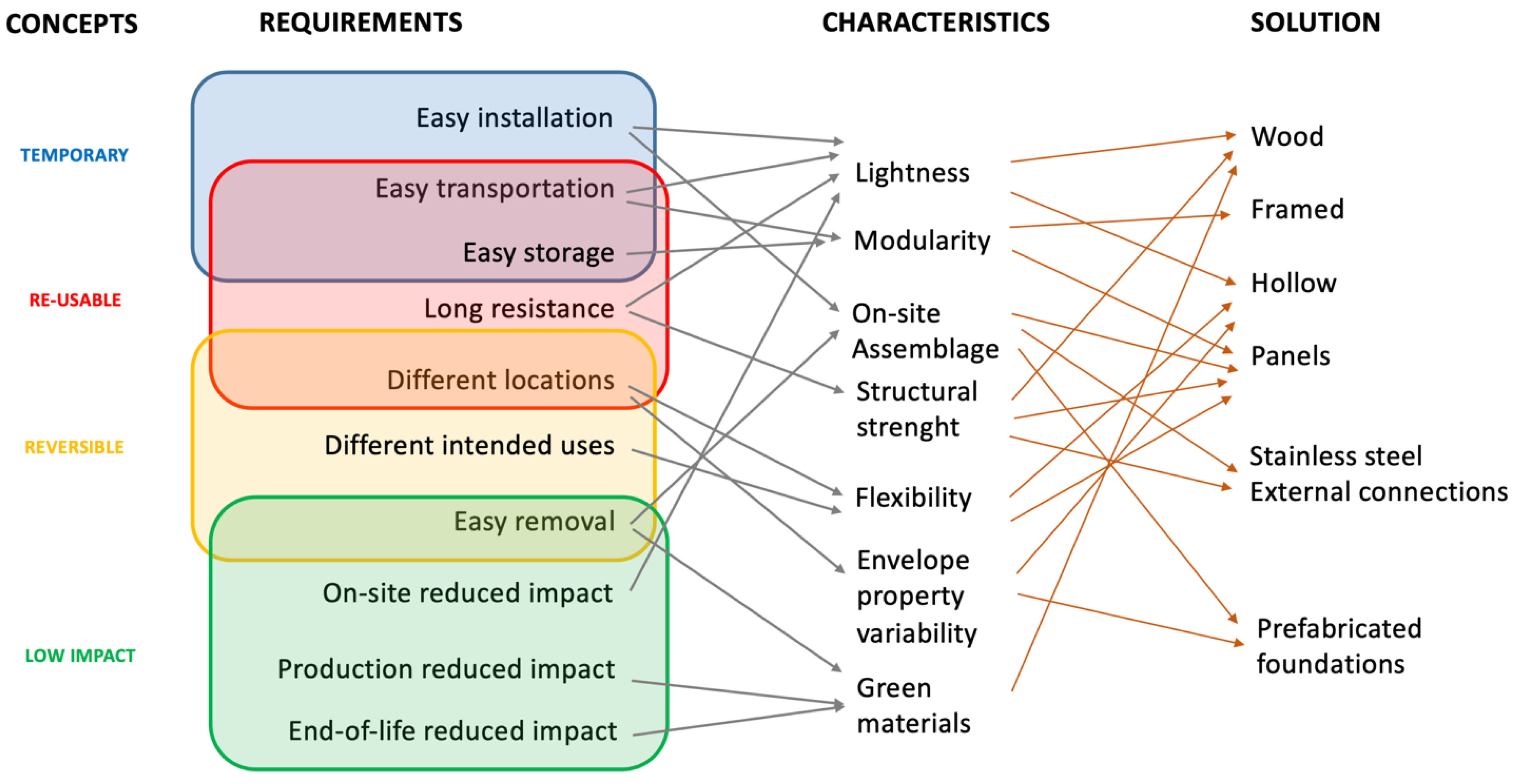
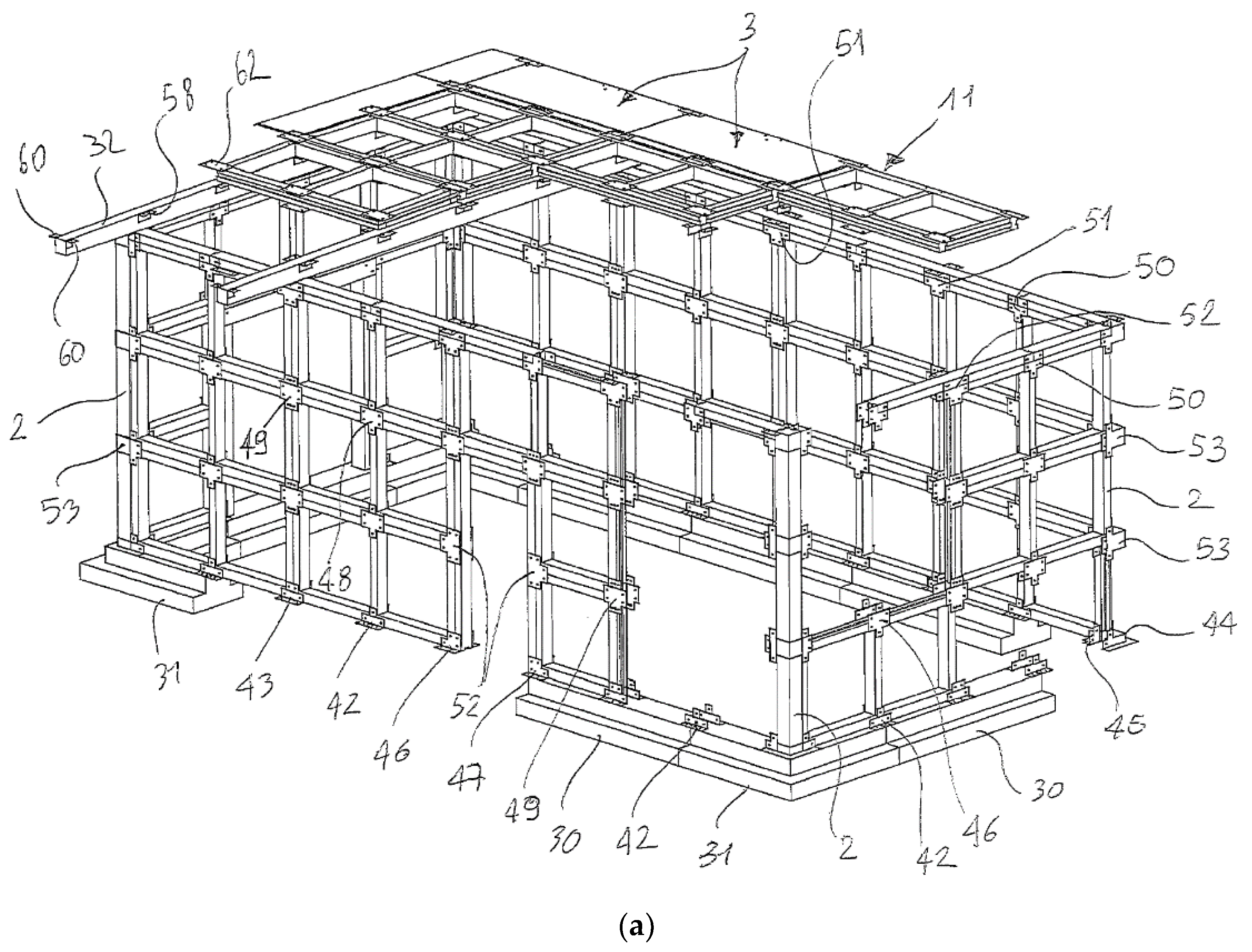
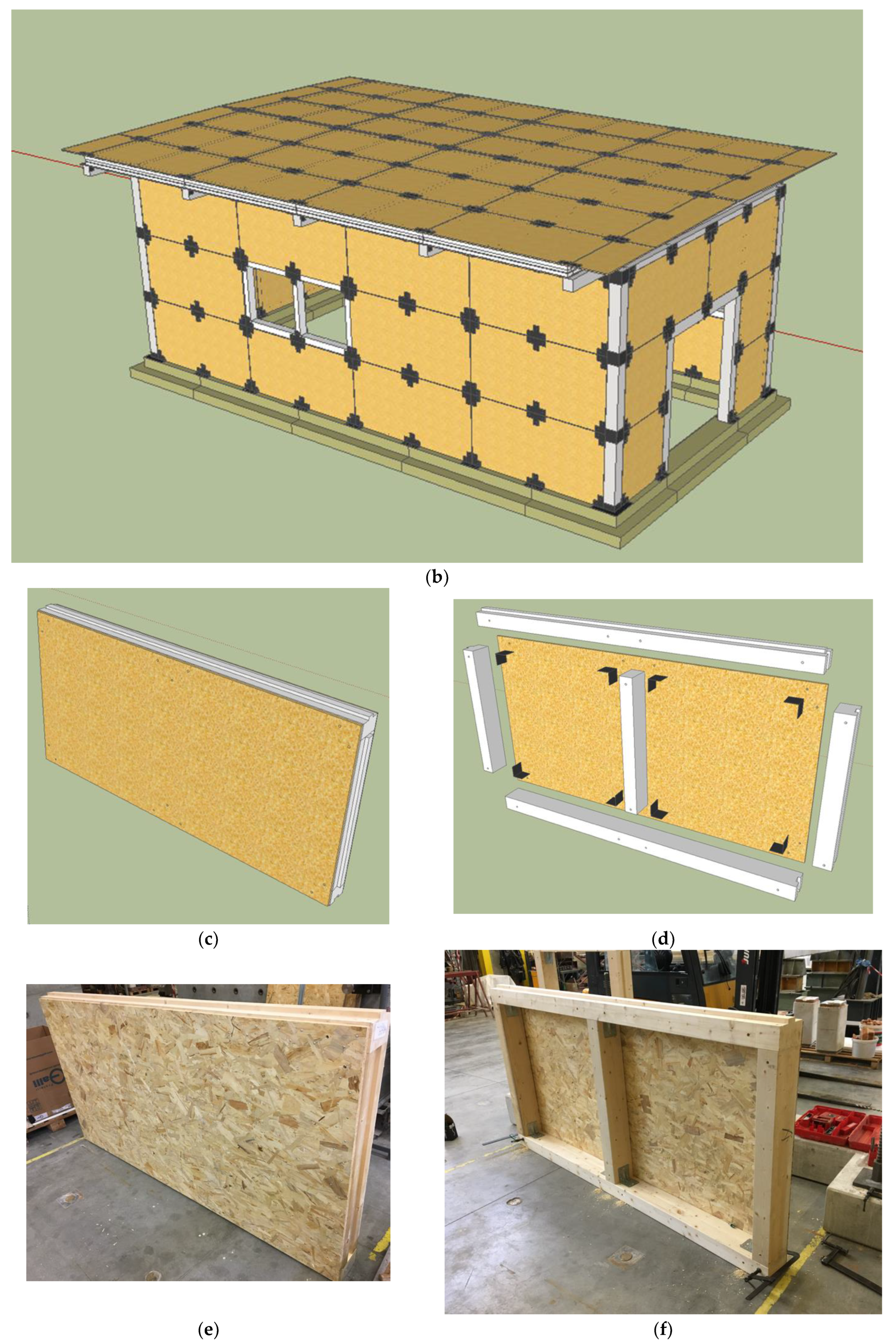




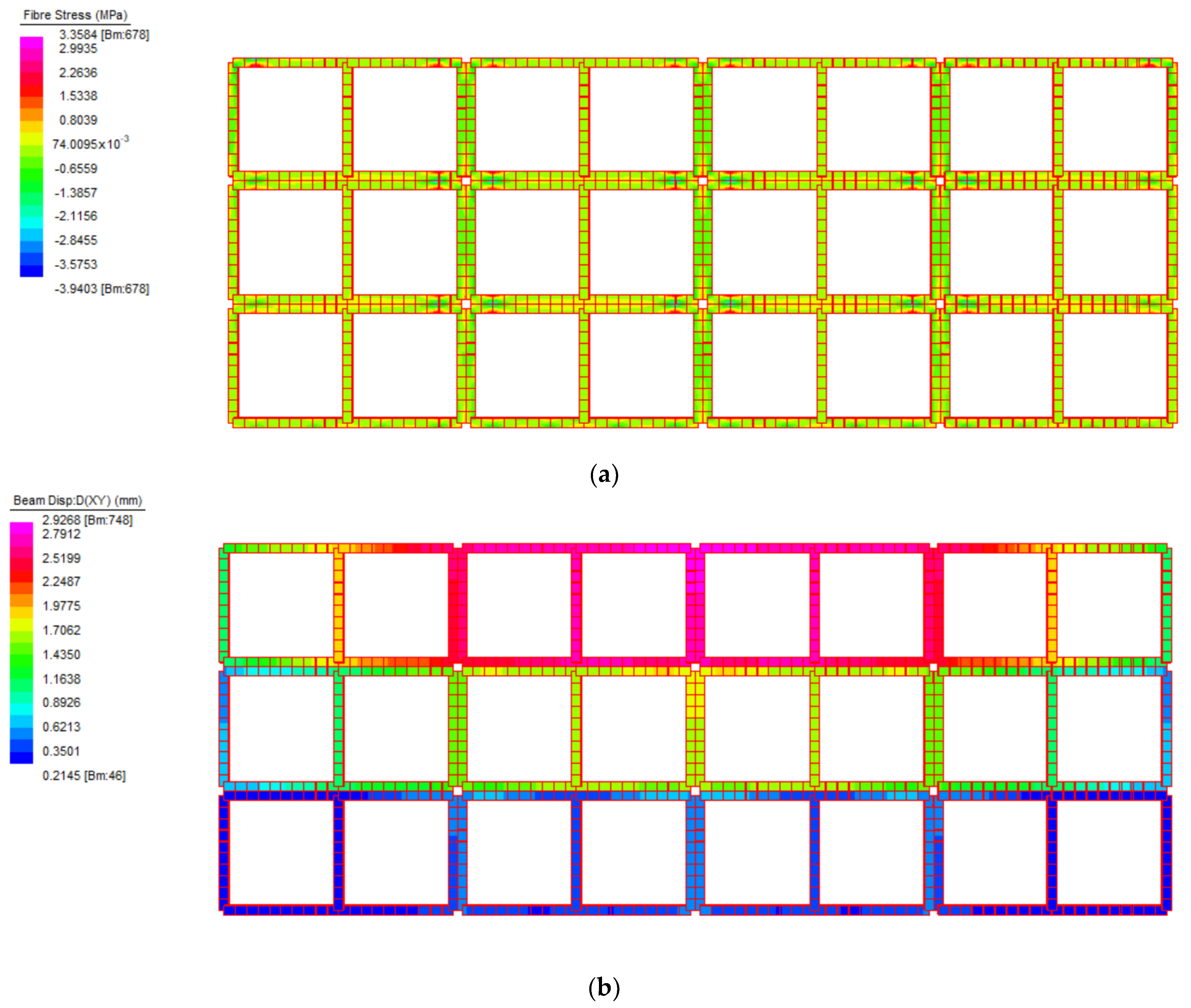

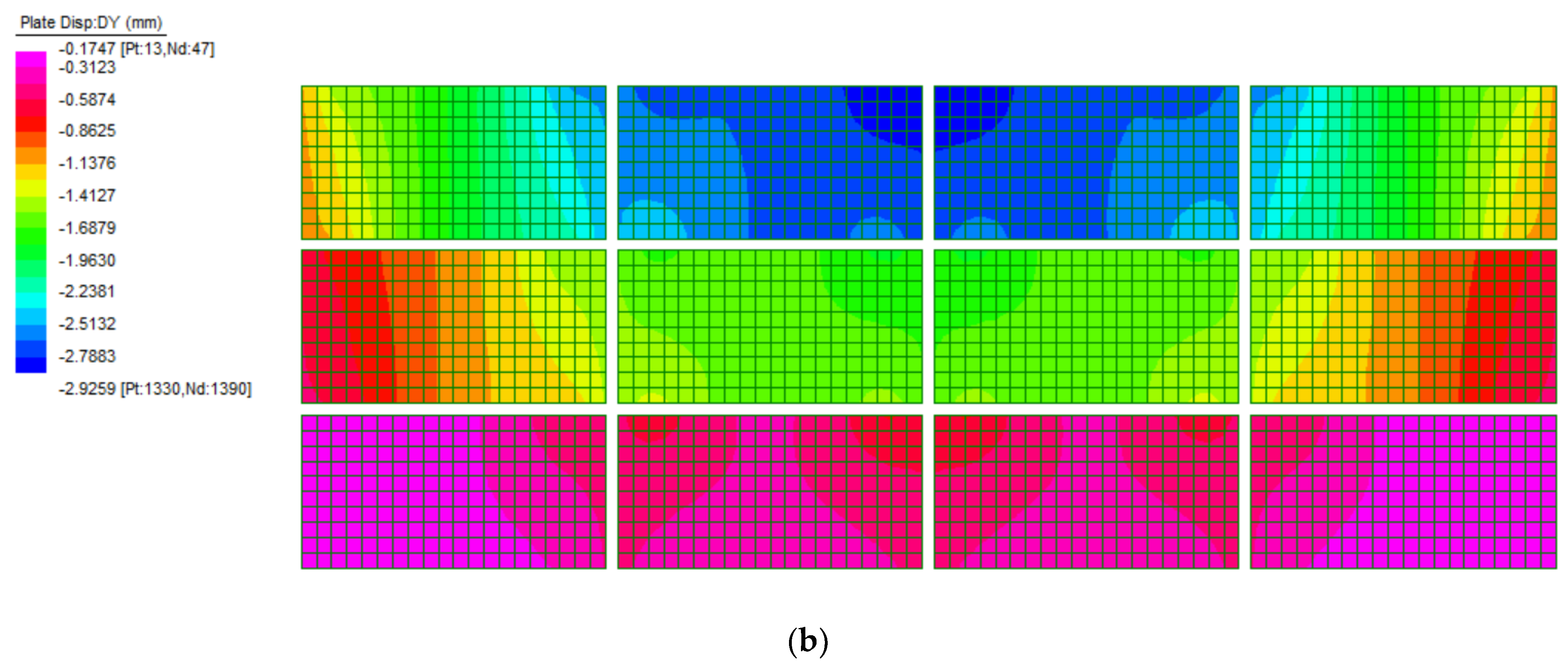

| Element | Material | Class | Note |
|---|---|---|---|
| Frame of the modules | Timber | GL24h | 160 mm × 100 mm (B × H) |
| Panel of the modules | OSB | Class 3 | BS EN 300:2006, thickness 22 mm 1250 mm × 2500 mm |
| Self-tapping screws for panel–frame connection | Steel | LBS-ROTHOBLAAS | Diameter 5 mm |
| Plate of the connections | Steel | S275 | Thickness 6 mm |
| Threaded bar for connections | Steel | 8.8 | Diameter M12 |
| Bolt for connections | Steel | 8 | DIN934, for M12 bars |
| Washer for connections | Steel | 440R | External diameter 44 mm, internal diameter 13 mm, thickness 4 mm |
| Foundation element | Reinforced concrete | Concrete C25/30; Steel B450C | Base 50/30 cm Height 40 cm |
| Thermal Transmittance | Periodical Thermal Transmittance | Attenuation | Thermal Lag | Surface Mass | Mass Increase | Average Panel Transmittance | |
|---|---|---|---|---|---|---|---|
| [W/m2K] | [W/m2K] | [-] | [h] | [kg/m2] | [kg] | [W/m2K] | |
| hollow volume | 1.639 | 1.581 | 0.965 | 1.51 | 25 | 1.353 | |
| frame | 0.543 | 0.147 | 0.270 | 10.67 | 90 | ||
| rockwool | 0.207 | 0.130 | 0.628 | 7.23 | 54 | 65 | 0.295 |
| cork | 0.240 | 0.141 | 0.585 | 7.63 | 44 | 41 | 0.319 |
| xps | 0.198 | 0.176 | 0.891 | 3.73 | 31 | 11 | 0.288 |
| corn cob | 0.515 | 0.299 | 0.581 | 6.95 | 60 | 79 | 0.522 |
| polyurethan | 0.127 | 0.094 | 0.742 | 6.11 | 33 | 15 | 0.235 |
Disclaimer/Publisher’s Note: The statements, opinions and data contained in all publications are solely those of the individual author(s) and contributor(s) and not of MDPI and/or the editor(s). MDPI and/or the editor(s) disclaim responsibility for any injury to people or property resulting from any ideas, methods, instructions or products referred to in the content. |
© 2025 by the authors. Licensee MDPI, Basel, Switzerland. This article is an open access article distributed under the terms and conditions of the Creative Commons Attribution (CC BY) license (https://creativecommons.org/licenses/by/4.0/).
Share and Cite
Bovo, M.; Santolini, E.; Barbaresi, A. An Alternative Modular Wooden System for Fast Assembly/Disassembly of Buildings. Buildings 2025, 15, 1196. https://doi.org/10.3390/buildings15071196
Bovo M, Santolini E, Barbaresi A. An Alternative Modular Wooden System for Fast Assembly/Disassembly of Buildings. Buildings. 2025; 15(7):1196. https://doi.org/10.3390/buildings15071196
Chicago/Turabian StyleBovo, Marco, Enrica Santolini, and Alberto Barbaresi. 2025. "An Alternative Modular Wooden System for Fast Assembly/Disassembly of Buildings" Buildings 15, no. 7: 1196. https://doi.org/10.3390/buildings15071196
APA StyleBovo, M., Santolini, E., & Barbaresi, A. (2025). An Alternative Modular Wooden System for Fast Assembly/Disassembly of Buildings. Buildings, 15(7), 1196. https://doi.org/10.3390/buildings15071196








